Module 3: Diversity of Microorganism
1/134
Earn XP
Description and Tags
exam review from lectures, supplemental material, packback, etc.
Name | Mastery | Learn | Test | Matching | Spaced |
|---|
No study sessions yet.
135 Terms
What is the most notable characteristic of the Phylum Firmicutes Gram-Positive Bacteria?
It is a “Low-GC” base-pairing content species. This means there is less than 40-50% of GC base pairs, so there are lower levels of stability because GC base pairs have 3 hydrogen bonds rather than 2 in AT base pairs.
What is the most notable characteristic of the Phylum Actinobacteria Gram-Positive Bacteria?
It is a “High-GC” base-pairing content species. This means there is more than 50-60% of GC base pairs, so there are higher levels of stability because GC base pairs have 3 hydrogen bonds rather than 2 in AT base pairs.
What are the character traits of phylum firmicutes?
Low-GC content
Monoderm (single-celled membrane)
Forms endospores
Many are pathogens
Example: C. botulinum
What are endospores?
They are dormant bacterial structures used to survive harsh environmental conditions. An endospore can remain dormant for months if not stressed out/triggered. The structure of an endospore is composed of multiple compartments, such as the spore coat (proteins), cortex (modified peptidoglycan), core (DNA, RNA, ribosomes, etc), cell wall (peptidoglycan), and membrane (lipids).
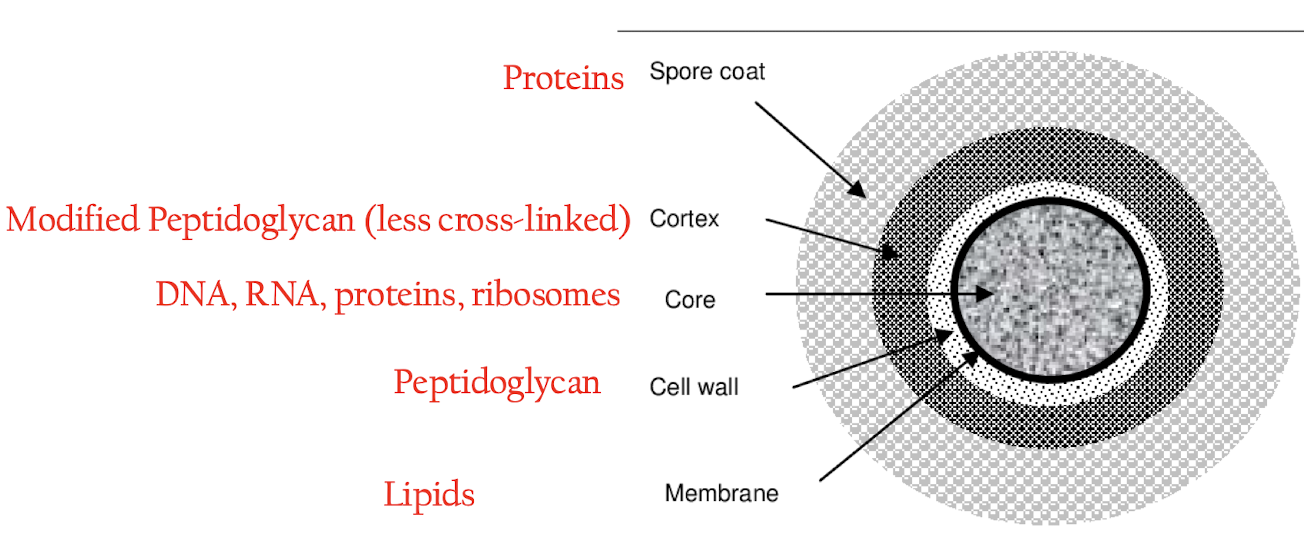
What are characteristics of the genus Clostridium?
Commonly has a LOW-GC content
Bacilli shaped
Obligate anaerobes
They form spores at one pole that look like a swollen terminal drumstick
Moonoderm (single-celled membrane)

What are the 6 steps to C. botulinum endospore formation?
Stressful conditions are needed to induce asymmetric division, initiating the sporulation process.
The forespore formed is then engulfed by the OG parent cell.
The cortex forms around the forespore inside the cell.
Multiple coats/layers form around the genomic material.
After the endospore has matured, mother cell lysis occurs to release the new viable spore cell into the environment.
The mother spore can then die, leaving only the single endospore as a way to allow the genetic material of the cell to survive without making a ‘daughter’ cell. The spore then germinates into a new bacterial cell under favorable conditions.
What are the characteristics of C. botulium specifically?
It is an agent of foodborne botulism
Common in the environment/soil
Spores allow dormant survival until ideal conditions such as being in anaerobic, nutrient-rich soil are met. That is typically deep in the soil. If there are C. botulium spores at the surface of the soil that get mixed around and exposed to air, then the endospores will produce and spread.
Spores, themselves, will not cause the toxic foodborne illness disease. Vegetative C. botulinum produces a powerful neurotoxin that is lethal to humans.
What happens if an infant gets exposed to the C. botulinum endospores or toxin?
Consuming raw honey before age 1 can cause infants with immature gut microflora to be at risk for endospore OR toxin exposure. Endospores can attach to their digestive tract, become metabolically active, and produce a toxin that crosses the tissue, enters the bloodstream, and causes neurological complications and muscle movement issues. The treatment is antitoxin intensive care.

What happens if an adult human gets exposed to the C. botulinum toxin?
In humans older than 1, honey (endospores) consumption poses little risk because their mature gut flora doesn’t allow C. botulinum to attach. However, exposure to the toxin via wounds, inhalation, or foodborne botulism through improperly canned foods can cause the endosperm that had germinated and become metabolically active elsewhere (outside the body) to then produce the toxin for ingestion. Human exposure at any age to the toxin alone can result in botulism. The treatment is antitoxin intensive care. Antibiotics do not help the treatment of C. botulinum.
What are the character traits of phylum actinobacteria?
High-GC content
Forms complex multicellular filaments that look like fungus
Can produce EXOspores
Acid-fast staining
Example: Streptomyces
What are exospores?
They are highly resistant, dormant structures produced by certain bacteria that grow and spread outside the cell (they do not get absorbed like endospores), allowing them to survive extreme environmental conditions. They can withstand heat, desiccation, and radiation. When conditions become favorable, they can germinate and return to their active, vegetative state.
What is the acid-fast staining technique used?
This refers to a differential staining procedure for bacteria that have mycolic acids and do not stain Gram-positive OR Gram-negative. This is used for phylum actinobacteria, such as in Mycobacterium.
What are the 3 steps to exospore formation in Streptomyces?
The formation of one or two germ tubes (drumsticks) causes a tip extension to form a network of branching hyphae (vegetative hypha).
In response to nutrient limitations or stress, aerial hyphae are erected (still vegetative).
Sporulation septa form and compartmentalize the sporogenic hyphae into box-like compartments. These compartments assemble a thick spore wall and are eventually released as dormant spores. The goal is to be able to move the genetic material if there is a debilitating environmental stressor.

What does vegetative bacteria mean?
It means that the bacteria is metabolically active and healthy.
What are the characteristics of the genus Streptomyces?
It looks like a fuzzy fungus with many color variants and growth patterns
It is common in the soil
Produces geosmin (a moist earth odor)
Non-pathogenic and can produce secondary metabolites that can have anticancer and antibiotic properties
Grows onto and into their substratum
Has linear chromosomes with telomeres
What are the 6 steps of the life cycle of Streptomyces?
It first MUST HAVE STRESS to cause the erection of aerial hyphae.
The older cells lyse themselves, and vegetative cells produce antibiotic compounds to kill competitors in the soil, and the sporulation of septation and chromosome segregation occurs.
Spore maturation occurs.
Arthrospores are produced (the name of the Streptomyces exospore) and are dispersed into the air.
The spore is germinated into vegetative hypha.
There is normal vegetative growth until stress occurs again.
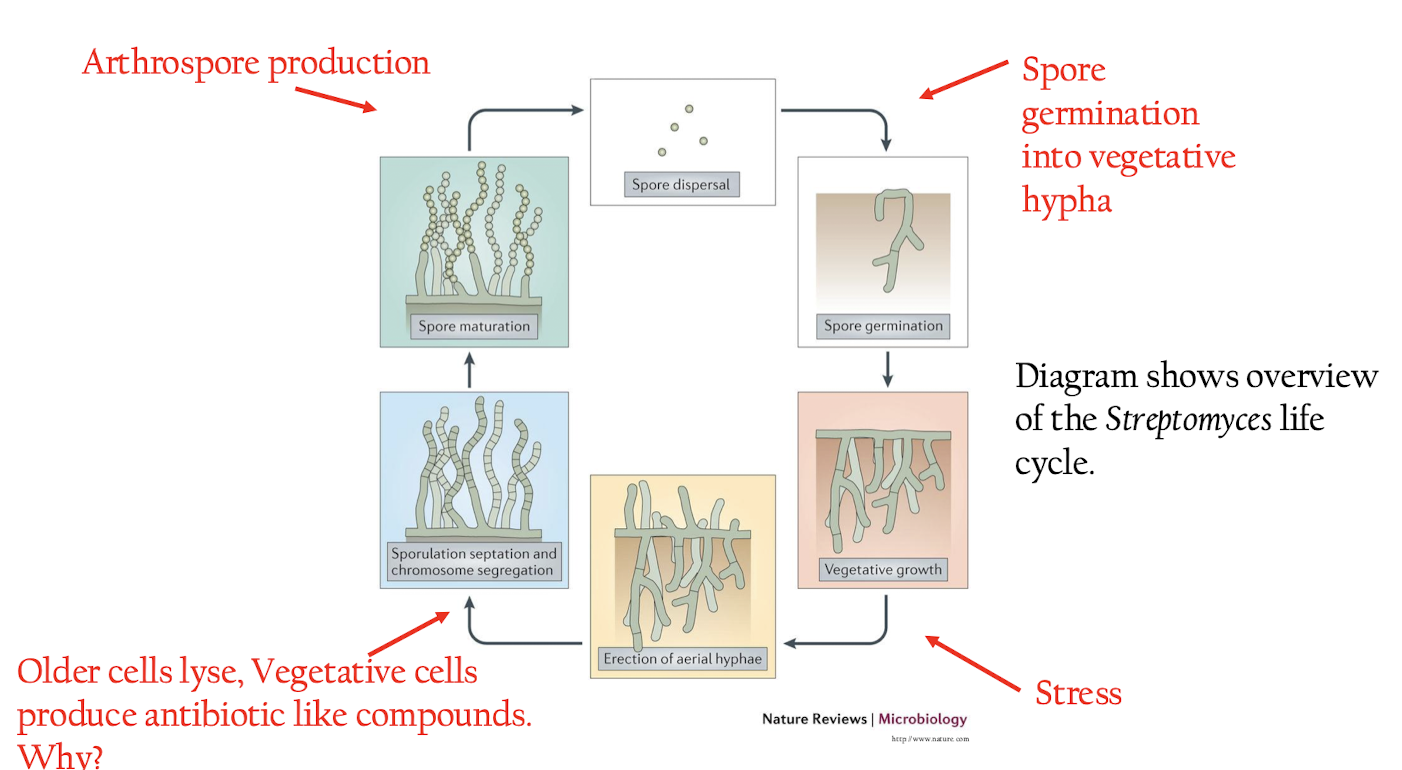
How do you distinguish the two phylum of gram-positive bacteria?
The main difference is that firmicutes have LOW-GC content, and actinobacteria have HIGH-GC content.
How can I compare and contrast infant versus adult cases of botulism? Include routes of exposure, complications, and treatments.
Infants are around 65% of botulism cases because their immature gut cannot block C. botulinum attachment. They can become sick from honey consumption (either endospores or toxin exposure) and die from neurological complications very quickly unless given intensive care with antitoxins.
Adult humans can only really become sick from toxin exposure via improperly canned food or exposed wounds, not endospore consumption. Botulism can develop unless also given intensive care with antitoxins. Botox is a very diluted C. botulinum purposely injected to paralyze the muscles.
What are the unique characteristics of the Streptomyces bacteria?
They produce EXOSPORES! They look like fungi as they form germ tubes at one pole that erect and disperse.
How can I compare and contrast between endospores and exospores? Include the formation process and examples of bacteria that produce them.
Both are survival structures produced by certain bacteria when in a vegetative state but their growth/development is triggered by stress. They protect the organism from harsh conditions.
Endospores form within the cell, while exospores develop outside the cell.
Endospores have a thick multi-layer protective coat, while exospores don’t and could be considered more ‘fragile’.
Endospore formation is typically primarily for survival as the OG parent cell dies once the new spore is released into the environment, while exospores can aid in both genetic reproduction and genome dispersal.
What was traditional microbial taxonomy like?
The name was NOT rooted in evolutionary relatedness. It instead referenced diseases they caused or process they performed. For example, Mycobacterum tuberculosis causes symptoms similar to tuberculosis!
What is modern polyphasic taxonomy like?
The name/family classification is rooted in the analysis of the genotype, phenotype, and evolutionary ribosomal RNA. It takes into consideration the multiple factors of an organism when categorizing taxonomic groups.
What are the two gram-negative major bacterial groups we study?
Deep-branching thermophiles and Cyanobacteria.
What are deep-branching thermophiles?
This gram-negative bacterial group consists of several phyla that diverged from ancestral archaea, making it the earliest sort of bacteria. It has the fastest doubling rate of all, but that means there are a lot of coding errors. This also means there is a high mutation rate. An example is Aquifex.
What is the phylum Aquificae in deep-branching thermophiles?
“Water makers” because they oxidize hydrogen gas with molecular oxygen to make water. They have unique Ether-linked membrane lipids (usually found in Archaea).
What is Thermocrinis ruber?
This is a bacterial species that belongs to the phylum Aquificae meaning it is a water maker by oxidizing hydrogen gas with molecular oxygen, and it is either linked. However, it also has the unique property of environment/media-dependant morphology change. On standard lab media grows as a bacilli (rod shape) but in its natural environment of water currents/streams, it grows as long thin intertwined filaments (streamers), making the bacteria initially difficult to identify/study. Research determined the temperature preference of both morphologies is the same (82-88˚C), and the difference is simply their growth pattern.
How does Thermocrinis ruber look in Yellowstone’s Octopus Spring?
It grows as a mat of long, filamentous, pink streamers at 82-88˚C. This bacteria prefers a warm environment rich in water flow.

What is the phylum Thermotogae in deep-branching thermophiles?
It is known as a bacteria that has a toga sheath. These sheaths are unlike classical Gram-negative outer membranes in that they balloon away from the cell at the cell poles. They are loosely bound, absent of a classic outer membrane. The reason for this ballooning membrane is unclear. This phylum also shares many genes with Archaea, called a mosaic genome of bacterial and archaeal descent.
What is Thermotoga maritima?
It is a type of bacteria in the phylum Thermotogae. It has one of the highest recorded growth temperatures of 90˚C (like in hot springs). During growth, the sheath extends from the poles. The outer envelope sheath “grows” as cytoplasmic growth “stalls”.
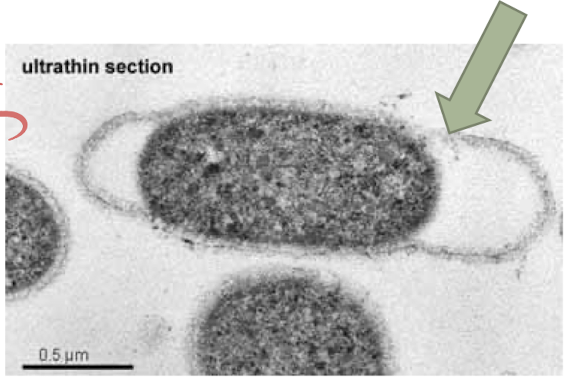
What is the phylum Chlorofelxi in deep-branching thermophiles?
They are bacteria that diverged later than Aquifex, which grow as filaments and are found to make microbial mats but not necessarily biofilms cause they do not produce EPS.
What is Chloroflexus aurantiacus?
It is a bacterial species within the Chloroflexus phylum. It is found in lower, deeper layers of microbial mats. They grow in a mat formation at 50-65˚C temperature range and also prefer a warm stream environment. It is atypical in that it does not have an outer membrane. It is also a gram-negative bacteria (meaning no teichoic acids/thin thick peptidoglycan).
What are SURFACE areas of biofilms/microbial mats occupied by?
Cyanobacteria
What are the phylum Cyanobacteria?
They are the largest, most diverse group of photosynthetic bacteria who are OXYGENIC (produces oxygen for their environment) and found in microbial mats. They have a thick peptidoglycan, similar to gram+ of 3-20 layers. They appear green because of the blue and red light pigment absorption from chlorophylls.
What kind of mutualistic associations does Cyanobacteria share?
As they are the main surface components of microbial mats (biofilms), they participate in multilayered relationships.
What is mutualism in microbial mats?
This refers to two or more organisms living in close association and providing benefits to each other. Typically in this type of symbiotic relationship the organism grow poorly without each other. Commonly between the layers of microbial m
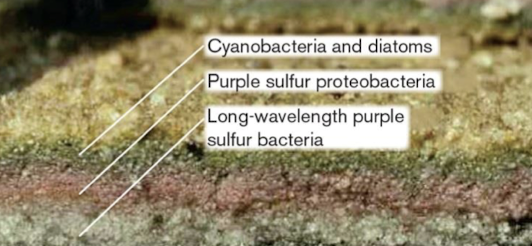
ats.
What are filamentous cyanobacteria formation?
Known as Oscillatoria filaments or pond cyanobacteria, consisting of platelike cells.
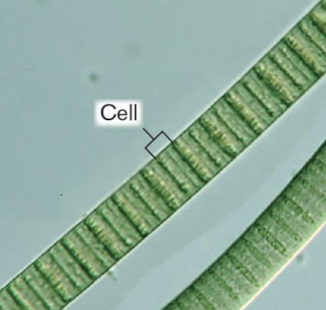
What are colonial cyanobacteria formation?
Known as Pleurocapsa, forms enormous aggregates that release baeocytes (means of asexual reproduction).
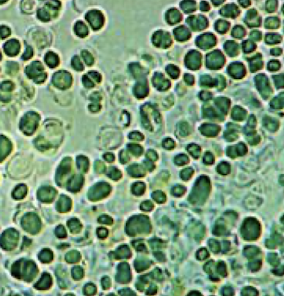
What are multicellular communities in cyanobacteria?
These communities contain several single-celled Cyanobacteria such as the genus Chroococcus (they surround themselves with other single cells and encase the community in a layer of protective mucus against environmental stressors).
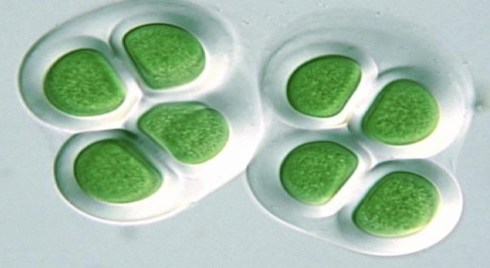
What are heterocysts?
They are specialized cells used for nitrogen fixation, produced when nitrogen-deprived. The cyst wall prevents oxygen gas diffusion, inactivating nitrogenase aka the enzyme necessary for nitrogen fixation. Cyanobacteria are known to contain heterocysts with specialized structures for nitrogen fixation. By providing a specialized environment for nitrogen fixation, heterocysts allow these cyanobacteria to contribute to the nitrogen cycle in various ecosystems, even under aerobic conditions. These structures are necessary because these bacteria live in oxygen rich environments and oxygen can inactivate the enzyme necessary for nitrogen fixation. Heterocysts provide a space with no oxygen therefore nitrogenase can work normally.
How do heterocysts form?
Multicellularity arises by various means. A. Filamentous cyanobacteria form chains by serial cell division. At intervals, a cell differentiates into a heterocyst.

What are the genus Nostoc?
They are a type of cyanobacteria that produces heterocysts, a typical filamentous cyanobacterium.
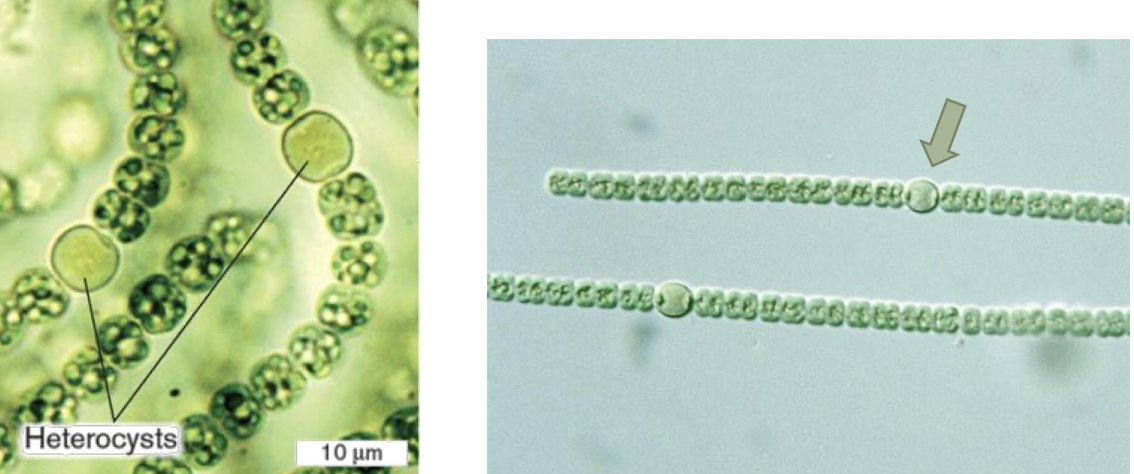
What are thylakoids?
They are the source of photosynthesis.
What are carboxysomes?
They are what fixes carbon dioxide.
What are characteristics of phylum cyanobacteria?
May have thylakoids or carboxysomes. Image is of Nostoc, a filamentous cyanobacterium.
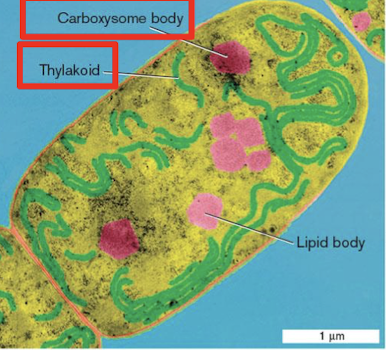
What are 3 types of cyanobacterium?
Nostoc, a typical filamentous cyanobacterium
Prochlorococcus, the smallest known phototroph that accounts for 40%–50% of marine phototrophic biomass
Synechococcus elongatus, grows at greater than 75˚C and prefers the warm stream water of Yellowstone Octopus Spring.
Yellowstone’s Octopus Spring is a rich community of gram-negative bacteria including what 3 main phyla?
Each phyla has its own unique cellular characteristics and temperature preferences.
Deep branching thermophiles
Chloroflexi
Cyanobacteria
What did Alexander Fleming begin in 1928?
The modern antibiotic revolution began with the discovery of penicillin when he observed a contaminating mold had inhibited the growth of Staphylococcus aureus colonies on a plate. He theorized that the mold released a substance that inhibited/killed the bacteria!
What is selective toxicity?
It is when antibacterials exhibit the toxic damage to only bacteria while limiting side effects upon the host. These levels are very high in strong antibiotics, impairing the harmful bacterial growth to restore the health of the host.
What parts of a bacteria’s physiology should antibiotics target with strong selective toxicity?
Generally
Peptidoglycan formation/structure (cell wall synthesis) inhibitors
Ribosome/protein formation/structure inhibitor
Biochemical pathways not present in eukaryotic mammals.
Specifically
DNA Gyrase (enzyme for unwinding DNA) inhibitors
Folic acid metabolism inhibitors
DNA-directed RNA polymerase (enzyme for RNA synthesis) inhibitors
Oxazolidinones
50S protein
30S protein
What are broad-spectrum antibiotics?
They are effective against many species and may harm even beneficial microflora, non-specific.
What are narrow-spectrum antibiotics?
They are effective against a few or a single species with a unique property
What are bactericidal antibiotics?
These antibiotics kill target organisms.
What are bacteriostatic antibiotics?
These antibiotics prevent growth of organisms. A human’s immune system would eventually kill the intruding microbe. Or anatomical actions would “flush” the microbe via the bladder.
Does a bacteria have to be bactericidal OR bacteriostatic?
Not necessarily. Some antibiotics are bactericidal at one concentration and bacteriostatic at another concentration.
What is the minimal inhibitory concentration (MIC) analysis?
This is where scientists try to find the lowest concentration that prevents microbial growth. It varies amongst different species and is found by testing different levels diluted antibiotics. No growth at the lowest level of concentration is key to minimize unwanted side effects of antibiotic overuse! It does not tell you whether the antibiotic is bactericidal or bacteriostatic, though.
What do MIC experiments look like?
In this series of tubes, tetracycline was diluted serially starting at 8 μg/ml. Each tube was then inoculated with an equal number of bacteria. Turbidity indicates that the antibiotic concentration was insufficient to inhibit growth. The MIC in this example is 1.0 μg/ml.
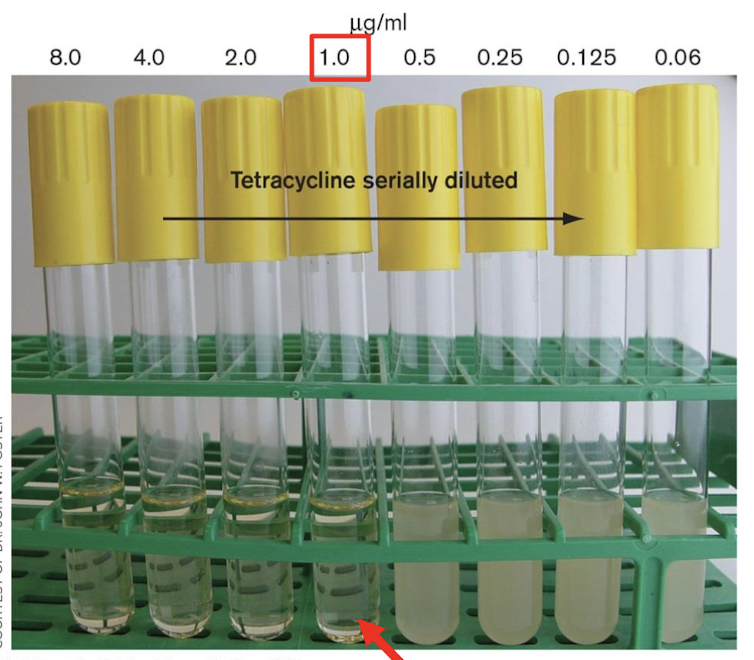
How could you determine whether the tetracycline in the MIC analysis above was bactericidal or bacteriostatic?
Subculture the filtered sample in a new environment. If there is bacterial growth, the tetracycline antibiotic is bacteriostatic since it just prevents growth in that one area. If there is no growth at all, tetracycline is bactericidal since it completely kills the target organism and prevents any continued reproduction.
What are the steps to peptidoglycan (cell wall) synthesis that antibiotics can target?
Precursors (NAG and NAM) are made in the cytoplasm.
Precursors are then carried across the cell membrane by a lipid carrier named bactoprenol.
The precursors are then polymerized to the existing cell wall structure by transglycosylases.
The peptide side chains are cross-linked by
transpeptidases.
What is bactoprenol?
It is a lipid carrier involved in the transport of peptidoglycan precursors (NAG and NAM) across the bacterial cell membrane for cell wall synthesis in bacteria, playing a crucial role in maintaining cell structure and integrity.
What are transglycosylases?
These enzymes are responsible for polymerizing the glycan strands of peptidoglycan by catalyzing the formation of βeta-1,4 glycosidic bonds between NAM and NAG. This action elongates the glycan chains that form the backbone of the peptidoglycan layer.
What are transpeptidases?
These enzymes crosslink the peptide stems attached to the glycan strands. They form peptide bonds between amino acids of adjacent peptide stems, creating a mesh-like structure. This crosslinking provides strength and rigidity to the cell wall.
What is MRSA?
It is a strain of Staphylococcus aureus (causes inflammation of the soft tissue) that does not respond to penicillin or methicillin. It encodes a specific gene called mecA which is a penicillin-binding protein.
What is the mecA gene in MRSA?
It allows MRSA to survive and grow even when treated with β-lactam antibiotics that would normally inhibit or kill susceptible S. aureus strains. The mecA gene encodes an alternative penicillin-binding protein that has a much lower affinity for β-lactam antibiotics compared to the native penicillin-binding proteins in S. aureus. This allows it to continue functioning even in the presence of these antibiotics. The mecA protein will bind to penicillin so that penicillin can attack cell wall enzymes.
What step of cell wall synthesis does Bacitracin target?
It targets peptidoglycan synthesis at step 2 (bactoprenol inhibition) by inhibiting the ability for precursors to be carried across the cell membrane. No precursors can cross! TOPICALLY ONLY, TOXIC IF INGESTED because it ruins the integrity of the cell wall.
What step of cell wall synthesis does Vancomycin target?
It is a bactericidal antibiotic that attacks everything for cell death at step 3 with transglycosylases. It uses its large size to block the cross-linking of the peptidoglycan wall and prevents the transpeptidases (like penicillin-binding proteins) from accessing their substrate and forming the cross-links, inhibiting cell wall synthesis.
What is VRSA?
It is a life-threatening condition and stands for Vancomycin-Resistant Staphylococcus aureus. If in-vitro susceptibility testing is promising, it can also be treated with Daptomycin.
What step of cell-wall synthesis does vancomycin target?
ONLY FOR GRAM+ POSITIVE BACTERIA! This antibiotic targets step 3 or the inhibition of cell wall synthesis by halting transglycosylases ability to polymerize the existing cell wall. It inhibits transpeptidase enzymatic activity by binding to peptidoglycan precursors (NAG & NAM).
The limitation of this antibiotic is that it is a large molecule that cannot transmit across the intestinal epithelium. This is why it is only in gram-positive bacteria as gram-negative bacteria have more membrane components to try and get through. This drug can be used to treat MRSA infections, but not VRSA infections.
Whis Daptomycin?
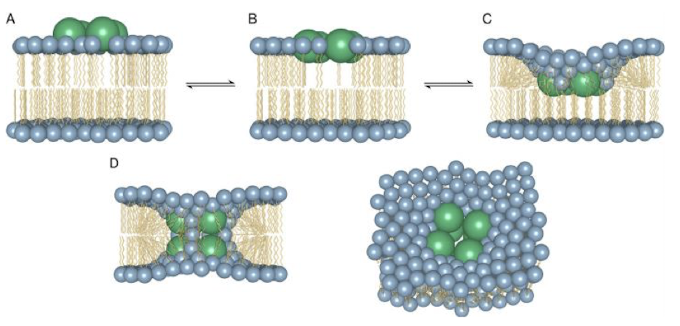
It is considered an alternative to vancomycin for MRSA bloodstream infections. Vancomycin remains the standard initial treatment, with this often used as second-line therapy, especially for infections with high vancomycin MICs or in cases of treatment failure. An early switch to daptomycin may provide mortality benefits in some patients. It demonstrates in-vitro bactericidal activity against a wide spectrum of Gram-positive organisms and kills bacteria without causing cell lysis.
What are the 4 basic forms/mechanisms of antibiotic resistance?
Alter the target
Degrade the antibiotic
Modify the antibiotic
Pump the antibiotic out of the cell
Antibiotic resistance genes can be plasmid-borne, or they can be part of the chromosome. Each specific antibiotic resistance gene product will use only one mechanism.
What does the first form of antibiotic resistance (altering the target) do?
It is when the gene of the target bacteria is modified so that it no longer binds to the antibiotic. The mutations in ribosomal proteins cause resistance to streptomycin since it cannot recognize the bacteria.
What does the second form of antibiotic resistance (degrading the antibiotic) do?
It is when the gene of the target bacteria can recognize and destroy an antibiotic before it even gets into the bacteria cell. The beta-lactamase enzyme specifically destroys penicillins by cleaving the beta-lactam ring of penicillins/cephalosporins via a serine hydroxyl group that launches a nucleophilic attack on the ring.
What does the third form of antibiotic resistance (modifying the antibiotic) do?
It is when the gene of the target bacteria can make enzymes that add modifying groups that inactivate the antibiotic. EX: Aminoglycoside-inactivating enzymes are different enzymes that can inactivate aminoglycoside antibiotics.
What does the fourth form of AR (pump the antibiotic out) do?
It is when the gene of the target bacteria can make efflux pumps in order to completely pump the antibiotic out of the cell and into the surrounding environment via specific transporters and transport complexes. A similar strategy is used in cancer cells. Of particular concern are multidrug resistance (MDR) efflux pumps. These efflux systems have promiscuous binding sites that can bind and pump a wide range of drugs out of the bacterial cell.
What are archaea?
This domain of life is the most ecologically diverse of the 3 domains, associated with extreme habitats.
What are archaeal cellular morphology?

Methanogens (Top 3): These show a wide range of shape lengths.
Methanosarcina mazei, a lobed coccus form lacking flagella
Methanothermus fervidus, a short bacillus
C. Methanobacterium thermoautotrophicum, an elongated bacillus
Bottom 2:
Haloquadratum walsbyi or square haloarchaea (very diverse) during their sixth round of cell division, which alternates in vertical and horizontal directions (photomicrograph, Nomarski optics).
Pyrococcus horikoshi
What is this archaeal organism?
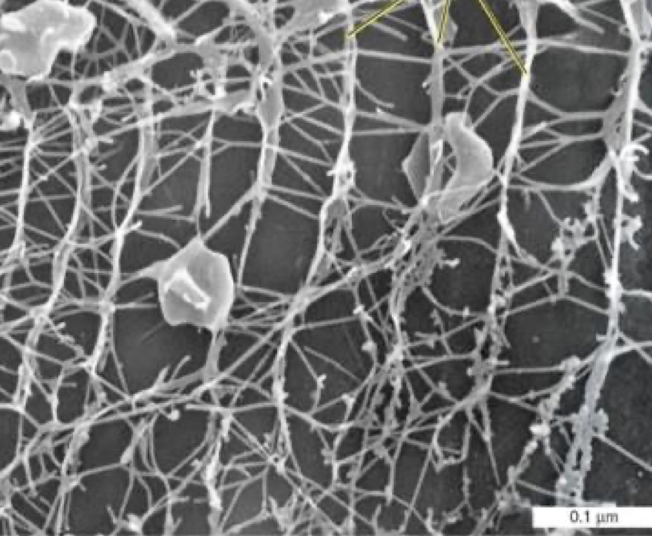
Pyrodictium abyssi, growing as networks of cells linked by cannulae which are tube-like projections that extend from the cell surface.
What do archaea have instead of traditional peptidoglycan in their cell walls?
They can have pseudopeptidoglycan, a molecule that has traditional NAG but not NAM instead N-Acetylalosaminuronic acid, making them biochemically different so antibiotics do not work the same.
What do archaea do when they don’t have any pseudopeptidoglycan?
They then develop envelops or s-layers that provide structural integrity. For example, A. Sulfolobus species have S-layer proteins plugged into a tetraether membrane.
What lipids do archaea use?
L-glycerol linked by ether R-O-R links. This is because ether links tend to have more stability than ester links, meaning breaking archaeal membranes requires more energy.
What lipids to bacteria and eukaryotes use?
D-glycerol linked by ester R-COO-R links.
What are the characteristics of archaeal genomes that are similar to bacteria?
Circular genome and small gene size and density. The genome has the presence of operons.
What are the characteristics of archaeal genomes that are similar to eukaryotes?
The genome coding sequence as the presence of introns for messenger RNA and the presence of histone homologes.

What are Ammonia Oxidizing Archaea?
They are archaea that oxidize ammonia to nitrate in cooperation with bacteria. It can be found in the ocean, recycle ammonia for the nitrogen cycle, provide nitrate for marine phytoplankton, and metabolizes ammonia to contribute to the control of skin pH. They are methanogens.
What are methanogens?
They are archaeal species that release methane from soil and digestive habitats. They contribute to human and animal digestion, not really harming anything (only other archaeal organisms). There is research on homeostasis underway.
What are Eukaryota?
This is one of the domains of life whose structure is defined by the presence of the TRUE nucleus and other membrane-enclosed organelles.
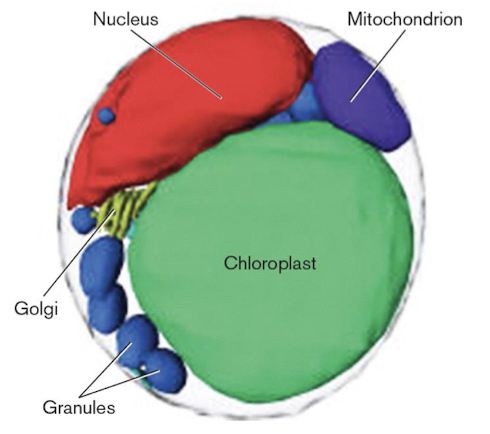
What are three challenges for classifying eukaryotes?
Complex eukaryotic cells frequently lose structures through reductive (degenerative) evolution.
Superficially similar forms of organisms have evolved
independently in distantly related taxa; this is called
convergent evolution.
The evolution of eukaryotes includes multiple events
of endosymbiosis.
What is reductive (degenerative) evolution?
It is when over time, a cell has lost structures compared to ancestors (no new structures).
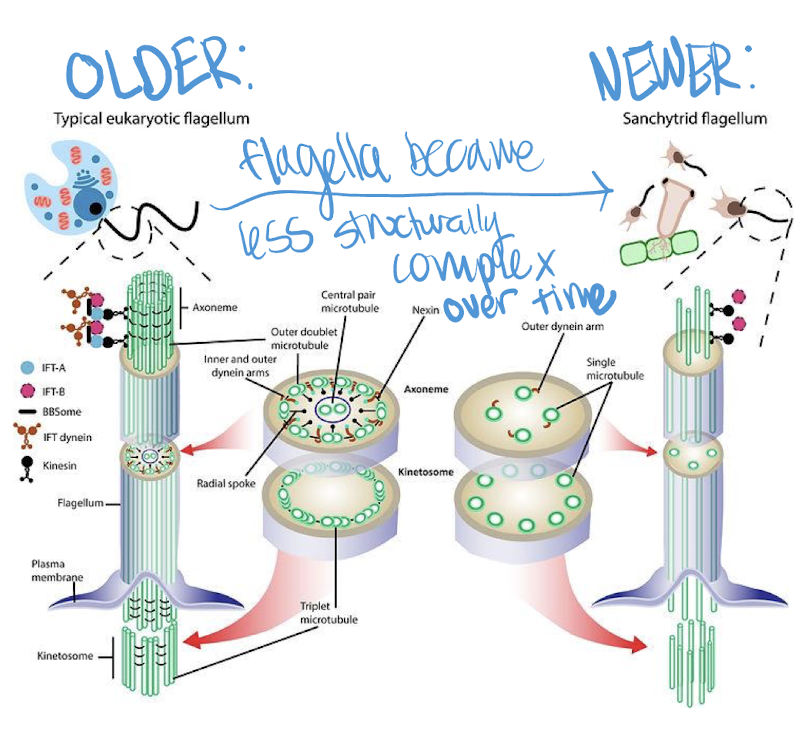
What is convergent evolution?
It is when organisms show the same phenotypic trait at first glance but still are different species with different ancestors, however maybe potentially they lived in similar environments causing similar evolutionary traits to develop.
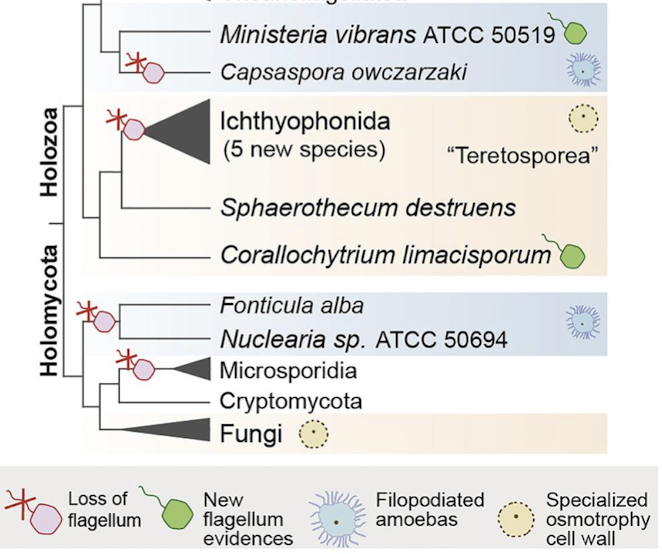
What is endosymbiosis?
It is when one eukaryote consumes a bacteria but instead of destroying it, a symbiotic relationship develops that makes them intertwined in supporting mutual growth/health.
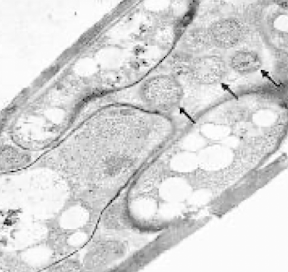
What are fungi?
Technically considered eukaryotic “microbes” but not bacteria because you don’t need a microscope to see them, so a weird in-between! They have absorptive nutrition, hyphae, cell walls that contain chitin, the singular cytoplasmic membrane containing ergosterol, and variable reproductive strategies.
What is absorptive nutrition?
It is something fungi can do when they secrete enzymes and then absorb the broken-down nutrients in the surrounding environment.
What is hyphae?
It is a cellular component traditionally in fungi with multi-nucleate cell filaments, which can extend and form branches used for reproductive purposes.
What is ergosterol?
It is common in the cytoplasmic membrane of fungi, and is similar to cholesterol in regards to providing structural integrity to the cell membrane.
What is Candida albicans?
Commonly known as a uni-cellular fungus that is apart of normal flora, however diseases that disrupt the levels can cause an overgrowth or yeast infection.
What are treatments to fungal/yeast infections?
Monistat anti-fungal topical cream for genital yeast infection
Itraconazole mouth rinse for thrush.
These anti-fungals prevent ergosterol formation, preventing cell membrane stability and causing cell contents to leak out, killing the yeast. These anti-fungals should be combined with probiotics to store the environment to normal flora levels.
What is Clostridioides difficile?
2-5% of adults carry this bacteria as part of normal flora of the gastrointestinal tract.
Gram+ positive bacteria
Anaerobic
Bacilli shape
Drumstick” when making endospores
Low numbers in flora
Other bacteria flora prevent C. diff overgrowth
Overgrowth leads to toxin production and disease
What is CDAD?
It is Clostridioides difficile Associated Disease. It is usually following recent host antibiotic usage and typically affects adults. C. difficile overgrowth leads to bacterial toxin release which causes colon inflammation and abdominal pain. The use of ANY antibiotic can lead to the increased risk of CDAD, however, broad-spectrum drugs increase the risk moreso.
What is Toxic-Mega-Colon?
It is a symptom of CDAD. It is the extreme dilation of the colon and risk of perforation (hole in colon). It causes severe diarrhea and nausea.
The use of any antibiotic can lead to an increased risk of CDAD. However, it has been observed that broad-spectrum antibiotics increase the risk for CDAD more so than narrow-spectrum drugs. How can you explain this phenomenon?
Broad-spectrum antibiotics increase the risk for CDAD much more than narrow-spectrum antibiotics because they have a stronger and wider impact on the gut microbiome, targeting both gram-positive and gram-negative bacteria instead of only a specific group of bacterial species. When a person starts to take a broad-spectrum antibiotic, the colon environment is at risk of developing CDAD because the antibiotics kill a wide variety of bacteria in the gut, including beneficial species that normally help maintain a healthy balance, disrupting the microbiome entirely. This extensive destruction weakens this natural defense mechanism, creating an environment where C. difficile can thrive and promoting the germination of C. difficile spores, leading to active CDAD infection. In contrast, narrow-spectrum antibiotics typically cause less extensive disruption to the gut microbiome because they only target specific bacterial species, leaving a larger portion of the beneficial gut flora intact.
The article noted that “Antibiotics can be effective in treating the first episode of C. diff. However, 10-20% of patients don't respond and the infection then recurs.” One antibiotic that is often used to treat CDAD is Vancomycin. What does it do?
The specific mechanism of action of Vancomycin that allows it to stop bacterial replication is Cell Wall Synthesis Inhibition or the blocking of peptidoglycan assembly, which prevents the incorporation of N-acetylmuramic acid (NAM) and N-acetylglucosamine (NAG) peptide subunits into the peptidoglycan matrix. This disruption leads to an incomplete and corrupted cell wall, making the bacteria vulnerable to bursting due to external forces like osmotic pressure. C. difficile could potentially resist vancomycin's action by altering the target attachment site, reducing vancomycin's binding affinity. The bacterium could also develop a thicker cell wall (making it harder for vancomycin to reach its target site) or produce enzymes capable of modifying or degrading vancomycin.